Kingdom of Oiseau
Summary:
The Kingdom of Oiseau, known in its native tongue as Royaume de l’Oiseau, is a beacon of cultural, artistic and societal excellence on the rest of the world. Headed Queen Louise XVII, the splendour and glory of Oiseau attracts the finest poets, musicians and artists from around the world and Oiseau is the Diamond in the Crown of Gaia herself.
National Flag

Naval Jack

War Flag

National Anthem
https://www.youtube.com/watch?v=6Xtm6zln5lg
Government:
L'état, c'est moi: «I am the Nation»-Queen Louise XIII
This statement by the late Queen, one of the greatest that Oiseau ever had, tells us much about how the nation is governed. The Kingdom is an Absolute Monarchy, where the Queen herself serves as the representation of Reine (Indeed, the Queen's title is Reine) on earth. In the hands of a wise Queen like Louise XIII, the state functions better than any nation on earth. But in the hands of a weak Queen, like her granddaughter, Louise XV, the state ceases to function properly and turns into a decadent mess.
Indeed, it was the reign of Louise XV that brought the greatest challenge to the state, in the form of the Caliphate of Batikh, invaders from the SEA into the realm. As a result of her disastrous reign, her daughter and granddaughter have given greater autonomy to local governors and military commanders. Gone are the games of Louise XIII in the court of Louise XVII. But the Absolutism still remains. All mechanisms of Government at the end are under the control of the Queen, and she can choose to end the autonomy if she wishes.
Culture and Society:
The splendour of Oiseau is seen best through her culture and society. The superiority of it is the envy of the whole world.
Refined Food:
Even the lowliest of peasants in Oiseau enjoy the most refined food in the whole world. The delicious bread made from local wheat, the brilliant beef from local cattle, the splendid succulent Fish harvest from the rivers, lakes and sea; oh, the joy that every soul enjoys.
Naturally, the rich eat the finest food, but the peasants have no reason to truly complain. Fillet Mignon, Roasts, Oysters, Lobsters, Fine Confectionaries, and the greatest wine on earth, the Rouge Royal grown only from the best grapes in Oiseau. Travelers come for the beauty but stay for the food.
Watermelons are the most beloved food in the Kingdom, a fine delicacy enjoyed by all. The sweetest, biggest and best melons on earth are grown in the Kingdom. Unfortunately, it was this that attracted the Terrorists to invade years before. If there is any reconciliation, it is that both enjoy the watermelons equally. One historic even was the meeting of Queen Louise XVI and the Caliph al-Watame Batikh in a celebration of Watermelons in 1102 VTE.
Fine Culture:
Only the best and most refined culture is accepted in the Kingdom. Fanfiction writing Excuse me, Poetry is considered a divine act that all citizens must partake in, and the act of writing Poetry of Adoration towards the Queen is extremely common. All Poetry dedicated to the Queen, the Goddess or others are encouraged to be read in front of audiences at Amphitheaters in cities, or even just the town square. Bad Poetry is considered a grave sin and can result in the imprisonment of the person who wrote it until they write something that makes up for it. Some people find themselves in prison for decades because they keep failing to write a proper poem. Poets from across the world come to the Court of the Queen knowing that the glory and splendour of her Patronage is one of the greatest experiences.
Music and other fine arts such as plays, architecture and painting are also heavily subsidized by the Crown. As with Poets, the same can be said about Musicians, Artists and Architects coming to the Kingdom to show off their true glory.
Everything about the Kingdom's culture is about the beauty that the work brings. It thus should be no surprise that the Kingdom has beautiful Royal Gardens and mere look of the average person and town is expected to be as prim and proper as possible.
Etiquette is essential for every Oiseaux, and failure to maintain it will result in one being shamed as Halu or imprisoned if the act was bad enough.
True Religion:
The True Religion, Reineism, is the worship of the Goddess and Patron of Oiseau, Reine Pavolia, and her divine manifestation on earth, the Queen. As such, the Queen is treated like the Divine Goddess herself and held to be infallible. But the Queen also serves this role as the divine mediator and the head of religion as well, which brings many responsibilities. All major religious ceremonies are conducted by the Queen herself, and require a great amount of charisma, as her power will be seen to be weak should her conduct be weak as well.
Beyond the Queen herself, Temples and Cathedrals are found across the realm dedicated to Reine. The inside of them is decorated with watermelon coloring, and divine masterpieces of art are made by the Queens of the Realm. Fishing is considered to be one of the most holy acts in Reineism as is the writing of poetry (fanfics). All citizens of the Kingdom are expected to partake in these two divine acts.
Divinely Mandated Class Structure:
The class structure for Oiseau has been handed down to us by Reine herself.
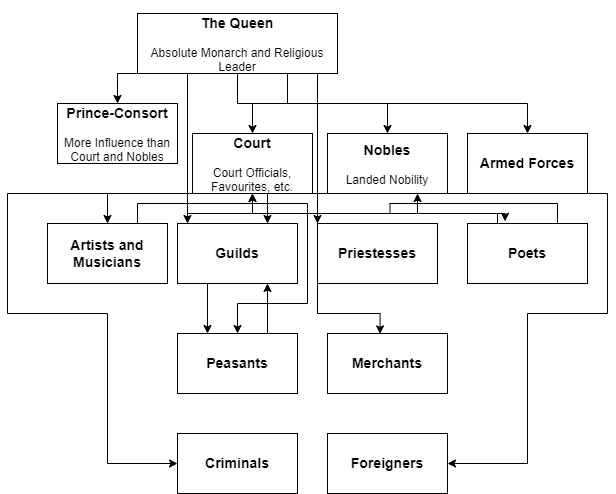 The monarchy is an agnatic matrilateral succession, only female can inherit the Peacock Throne.
The monarchy is an agnatic matrilateral succession, only female can inherit the Peacock Throne.
Geography
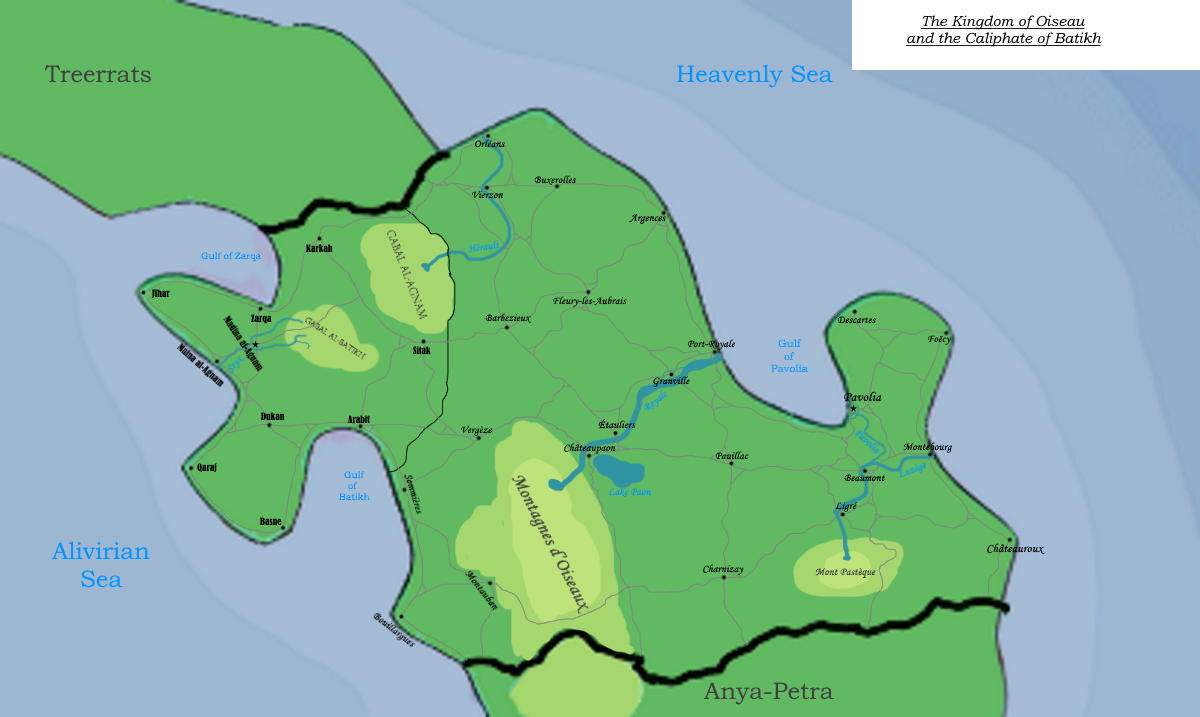 The Kingdom stretches from the Alvirian Sea in the West to the Heavenly Sea in the East. From the borders of the Tribal Kingdom of Risu in the North to the Dual Monarchy of Anya-Petra in the South. Not counting the unrecognized terrorist «state» that inhabits the Northwest, the total land area of the Kingdom is 3735 kilometres total.
The Kingdom stretches from the Alvirian Sea in the West to the Heavenly Sea in the East. From the borders of the Tribal Kingdom of Risu in the North to the Dual Monarchy of Anya-Petra in the South. Not counting the unrecognized terrorist «state» that inhabits the Northwest, the total land area of the Kingdom is 3735 kilometres total.
 The climate of the Kingdom is determined by the magical presence of the Queen herself and Reine, which when the Kingdom was founded turned the overbearingly hot lands into a warm and hot Mediterranean climates. The Terrorist state revert back to its deserts and semiarid land as part of the mystical existence in part of their lands.
The climate of the Kingdom is determined by the magical presence of the Queen herself and Reine, which when the Kingdom was founded turned the overbearingly hot lands into a warm and hot Mediterranean climates. The Terrorist state revert back to its deserts and semiarid land as part of the mystical existence in part of their lands.
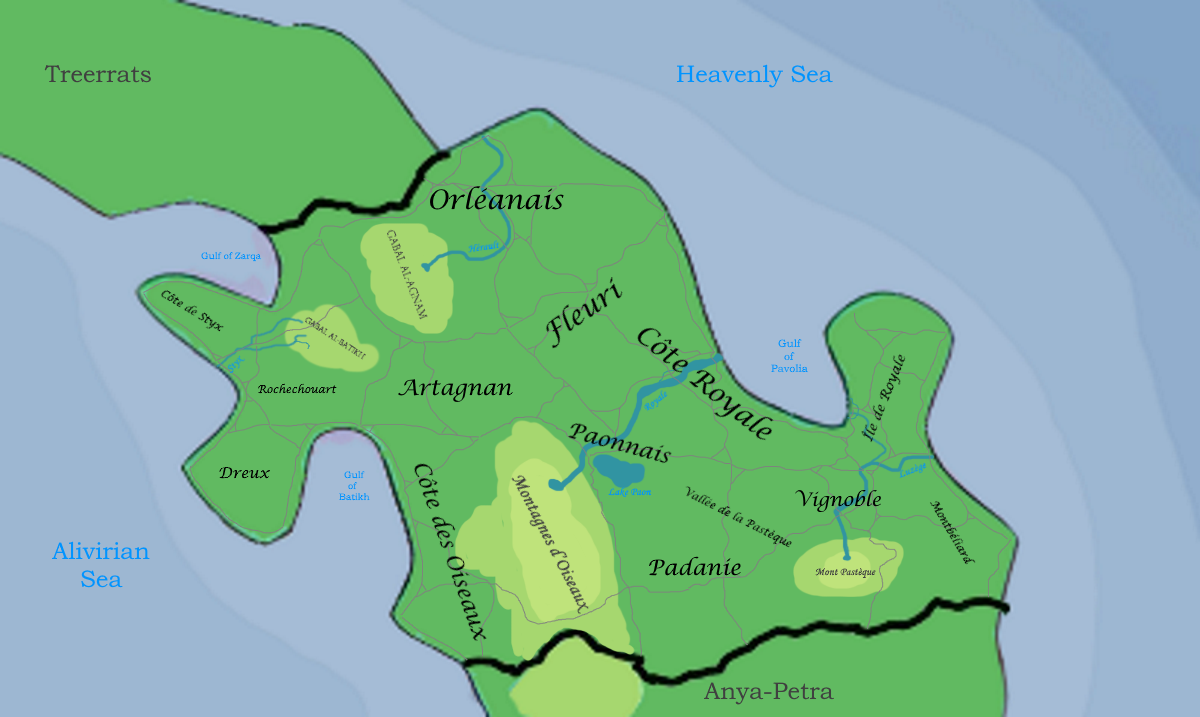 The Kingdom (and Caliphate) have at total of 14 provinces, with the Kingdom only fully controlling 10 of them and one of them being contested
The Kingdom (and Caliphate) have at total of 14 provinces, with the Kingdom only fully controlling 10 of them and one of them being contested
Places of Note:
Pavolia:
The political and cultural capital of the Kingdom. Known as the Queen City, it has been around since the beginning of the nation and is a luxurious city with many gardens, fountains, statues, palaces and more. The Queen's winter palace in the city and most major religious festivals are held here as well
Port-Royale:
The economical heart of the Kingdom. A sprawling metropolis with a grand harbor, large merchant quarter and splendour only outdone by Pavolia and equaled by Orléans.
Orléans:
A great port and cultural center in the northeast. Historically the second largest city in the Kingdom until it was overtaken by Port Royale in recent years. Has as much Splendour as Port Royale, if not more.
Châteaupaou:
The Summer Palace of the Queen. This site was built near Lake Paon by Louise XIII to make the center of the Kingdom closer to the actual center in order for bureaucracy to run smoother, that was the story at least. The real story is this land has been used to produce the greatest royal palace on earth, unrivaled in size and splendour.
Lake Paon:
A Holy Lake, and popular tourist destination by the Nobility. The Queen has a private sector of the lake to herself.
Economy:
The Kingdom's economy has long been blessed by Reine and our Queen. It is well developed in many sectors and has much to offer its worthy friends as a trade partner.
Primary Sector
Agriculture:
Agriculture is a fundamental part of Oiseau's economy and many of her subjects serve this role for her greatness. The primary staple crops produced by the farms of the Kingdom are Wheat, Barley, and Rye. These crops are used as food for the nation in some form, whether it be in bread, confectionaries, or as fodder for livestock.
The other main crops grown are fruits and vegetables, which include tomato, artichokes, lettuce, asparagus, spinach, broccoli, celery, onions, parsley, apples, olives, grapes, oranges, lemons, pears, apricots, hazelnuts, peaches, cherries, plums, watermelons, strawberries, and kiwifruits.
Olive Oil and Wine amongst the nation's most sought-after products, being unmatched in quality and are a point of pride that the nation holds. Purple dye, Velvet and indigo are also produced.
Pastoralism is also a common part of the agricultural sector, with cows, sheep, swine, chickens, goats and horses all being raised on Oiseau pastures. They each serve their purpose in the Agricultural sector, with Horses for example being used to help plow fields and being sold to the army or civilians for travel, while Cows are used for their milk and beef.
Mining and Logging:
The Mining industry is largely concentrated around the Padenie region and plays its role in the economy and the industrialization of Oiseau in the future. Bituminous Coal, Iron, Copper, Asbestos, Salt Peter, Lead, Bauxite, Sulphur, Marble, Diorite, Quartz, and small amounts of Gold, Rubies, Amythest and Sapphire.
The logging industry is an important part of the economy and has a long industry. Clearcut logging has cleared much of the old growth forests away, but the strategic logging reserve is based on the Bird Mountains and there is still plenty of wood that is chopped down.
Fishing
One of the most sacred acts in the Kingdom is fishing and it is no surprise that Fishing is a major part of the economy too. Whether it is normal fish or luxury fish, it is no secret that the Kingdom places emphasis on the Fishing Industry itself and its protection by the Royal Fisherman Guild or Guilde royale des pêcheurs. Founded by Louise IX, every Fisherman in this guild is protected by the Queen's power from abuse by internal and external forces. It is the largest guild in the Kingdom by far.
Secondary Sector:
The secondary sector is robust and a growing sector with many different industries popping up across the Kingdom. These include Steel, Textile, Tool and Die, Paper, Chemical, Weapons, shipbuilding, distilleries, wineries, Canneries, Dye works and luxury good industries
The industries themselves are usually located near rivers or the ocean, where the transportation of goods is far easier to complete.
Tertiary Sector:
The State Bank or Banque Royale is the only permitted Bank in the Kingdom, which forbids usury. There are Guilds for just about every single industry and trade within the Kingdom, all of which are beholden to the Crown who protects them and mediates over them. Merchants are usually kept within their own quarters in authorized ports unless the nation at hand has been given permission, albeit limited to trade across the realm. t
Shortlist for Trading:
Note: We only will trade with a nation we consider refined enough to earn the honor of trading with our nation. Begone beggars!
Fish, all kinds, smoked if desired
Clams
Oysters
Pearls
Lobsters
Crabs
Rubies
Sapphires
Amythest
Furniture
Vintage Wine
Olive Oil
Cannons
Gunpowder
Muskets
Armor
Sulfur
Paper
Many tools and die
Dye
Fine Glass and Porcelain
Jewelry
Machine Tools
Fine Textiles
Canned Goods
Fine Leather
Fur hats
Clocks
Velvet
Powdered Wigs
Tomatoes
Artichokes
Broccoli
Asparagus
spinach
Lettuce
meat, smoked or dried
celery
onions
Apple Cider
Apples
Lemons
Oranges
Parsley
grapes
olives
pears
apricots
hazelnuts
peaches
plums
cherries
kiwi
strawberries
wheat
barley
rye
cheese
All types of things produced by these food products
Quartz
Marble
Diorite
Asbestos
Pet Birds
Watermelons
Currency:

Armed Forces:
There are no greater armed forces in the world that those under Her Royal Majesties' Command. But how could a nation of poets, artists and musicians say such as thing? Simple, there are no more splendidly dressed, Élan filled and well lead soldiers in the world. Unlike our neighbors who boast about their greatest, the Royal Armed Forces have fought many wars and won just as many. This is where our pride comes from.
Royal Army
The Royal Army numbers in total 200,000 men and is tasked with combating all threats on land to Her Royal Majesty, both internal and external.
Infantry
Infantry is the basis of any modern army and is the backbone of the Royal Army. There is a total of 85 Regiments of Infantry in the Army.
Line Infantry:
Aside from a few specialized units, Line Infantry is the basis of nearly all infantry units in the army. Each regiment of Line Infantry has 2 Battalions in them which in turn have 8 companies. 1 of these companies are Grenadiers, which are the tallest and strongest men in a battalion, while another is a Fusilier, a company that can fight in both line formation and as skirmishers. The latter was part of the 1099 Army Reforms conducted by Marshal Hans-Pomu von Bülow in response to the Caliphate when it became apparent that Line Infantry needed to be more flexible.
Specialists
Specialist infantry units also make up a small, but important part of the Royal Army. The war against the Caliphate has given rise to the need of all specialist Light Infantry units. Chasseur Battalions were first raised in 1065 in response to the need for light infantry specialists, and as time has gone on, more of these battalions have been raised. The 1099 Reforms increased the number of Chasseur Battalions to 20 and these battalions are vital for any combat against the Caliphate.
Engineer Battalions also are important, as the construction of fortifications and defensive works by Armies on campaign has become apparent in recent years. There are currently 10 Engineer Battalions which operate with the forces facing the Caliphate and they are also important in operations against them as the works they set up can offset some of the disadvantages
Cavalry
If the Infantry is the backbone of the army, the Cavalry is the arms and legs of the army. Cavalry as a whole serves a variety of roles, depending on the type of Cavalry and is crucial for the success of the Royal Army.
Heavy Cavalry:
Heavy Cavalry has always been a forced to be reckoned with throughout all of history. Despite their importance decline as a whole in the last few centuries, there role as shock cavalry is still unmatched. Cuirassiers, and Carabiniers are important in this role, with the Army having 6 Cuirassier Regiments and 2 Carabinier Regiments
Medium Cavalry:
Medium Cavalry serves an intermediate role between the Heavy and Light cavalry units, being able to do roles of both but not at the same abilities. This has led them to be used more as Heavy Cavalry units in recent years, and Medium Cavalry as a whole is now entirely Dragoons. Dragoons used to be Mounted Infantry that would dismount to key locations, but this role has decline and now Dragoons serve more as Heavy Cavalry units that can potentially dismount as infantry rather than the other way around. There are 12 Dragoon Regiments in the Royal Army and there is currently a discussion about specializing these Dragoons into both roles, with Heavy Dragoons and Light Dragoons as possibilities.
Light Cavalry:
Light Cavalry are the eyes and the ears of the Royal Army and are extremely important to its success. They also can prove to be quite effective in combat when used properly. Hussars and Lancers serve as the army's scouts, screening forces, skirmishers and escorts on campaign. Light Cavalry appeals in particular to some of the dashing gentlemen, and Hussars are known in particular for being quite the lady killers. 16 Hussar Regiments and 4 Lancer Regiments exist in the Royal Army.
Artillery:
If Infantry is the Backbones and the Cavalry is the arms and legs, the Artillery is the fist of the army. Artillery, when used correctly, is devastating to enemy ranks. Indeed, the saying of «Artillery is the God of the Battlefield» remains true.
Field Guns are the most common type of cannon used, with Howitzers and Mortars serving their own purposes. Artillery is organized into Battalions, of which there are 48 in total. Each Battalion has 4 to 6 batteries in them. Artillery is also classified in organization between Foot Battalions and Horse Battalions. Horse Battalions use lighter guns and commonly operate with Cavalry. 12 Horse Artillery Battalions exist in the Royal Army.
Currently, the Royal Army is considering reforms to their system of artillery to reduce the number of calibers of the guns, reduce number of carriages and cassions, and standardize artillery as a whole. Engineers are also being considered to be moved to this branch of the army and there is a debate on whether to make full artillery regiments that would be detached to each division in field armies.
Étrangers:
Régiment Étrangers, are foreigners that the Kingdom sees as men worthy of fighting on behalf of Her Royal Majesty. These foreigners are expected and do act as truly noble, brave and refined men-of-arms and we considered them to be a precious part of the Army and the nations who send them as true friends.
Pomeranians
Pomeranians are the most well-drilled and disciplined soldiers in the world, as fact that has been proven over and over by their success in their own lands and in service of others. They were first introduced into the Royal Army in 1072, and their reputation was quickly proven to us in the first engagement they fought in against the Caliphate, where their impeccable drill, and rate of fire won us the day.
5 Pomeranian Regiments currently serve in the Royal Army, one of which being part of the Royal Guard. The four regular line infantry regiments are the:
44ème Régiment d’Infanterie de Ligne or «Régiment de Königsmarck»
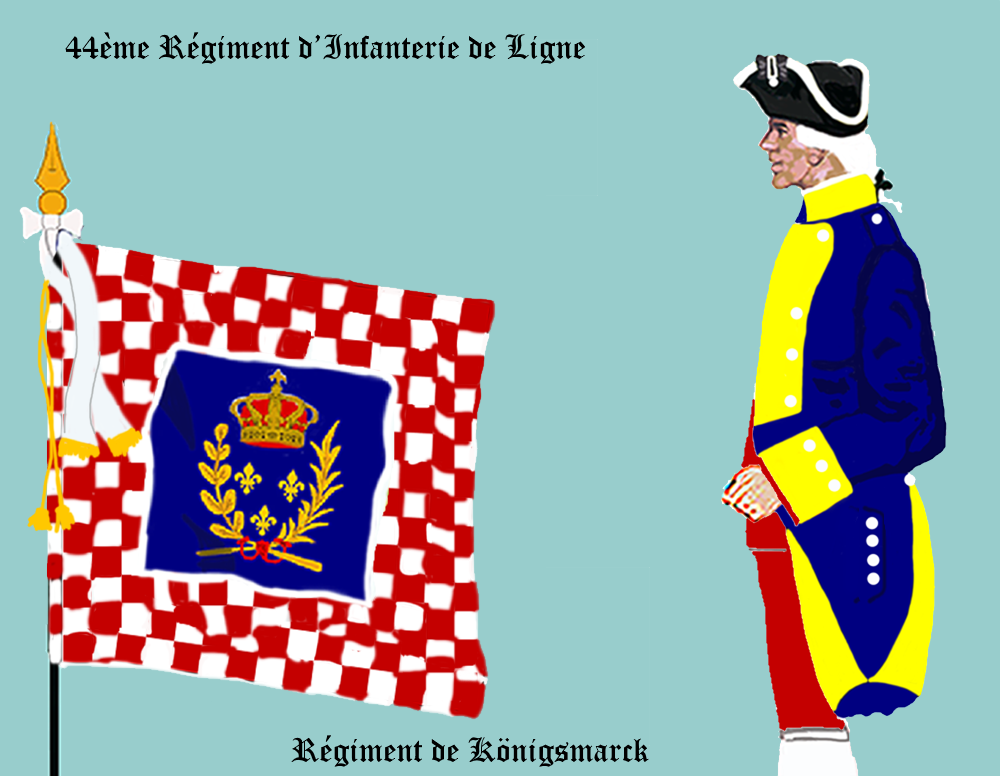
47ème Régiment d’Infanterie de Ligne or «Régiment de Mansfeld»

58ème Régiment d’Infanterie de Ligne or «Régiment de Quedlinburg»

62ème Régiment d’Infanterie de Ligne or «Régiment de Salzwedel»

Syndeonians
Syndeoneian refugees have been accepted into Oiseaux society following their national catastrophe 20 years ago. As the Empire and the Kingdom have always had cordial relations, these refugees were introduced into the Royal Army in 1115 and have proven their worth already. Two Regiments of Line Infantry have been drawn from the Syndeoneians.
74ème Régiment d’Infanterie de Ligne or «Régiment de Antiocheia»
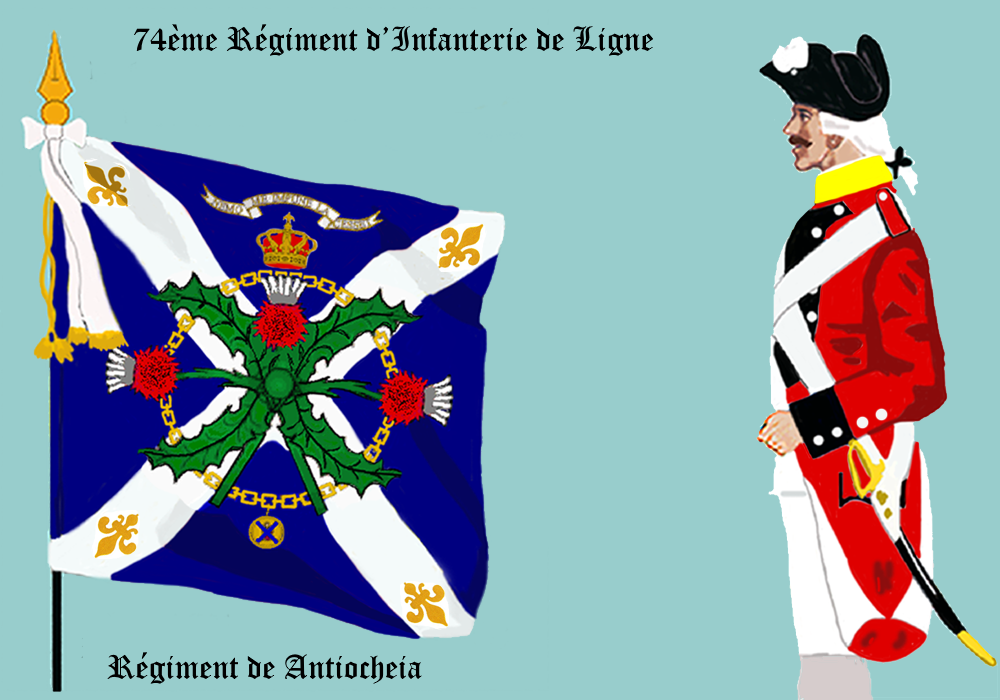
77ème Régiment d’Infanterie de Ligne or «Régiment de Thera»
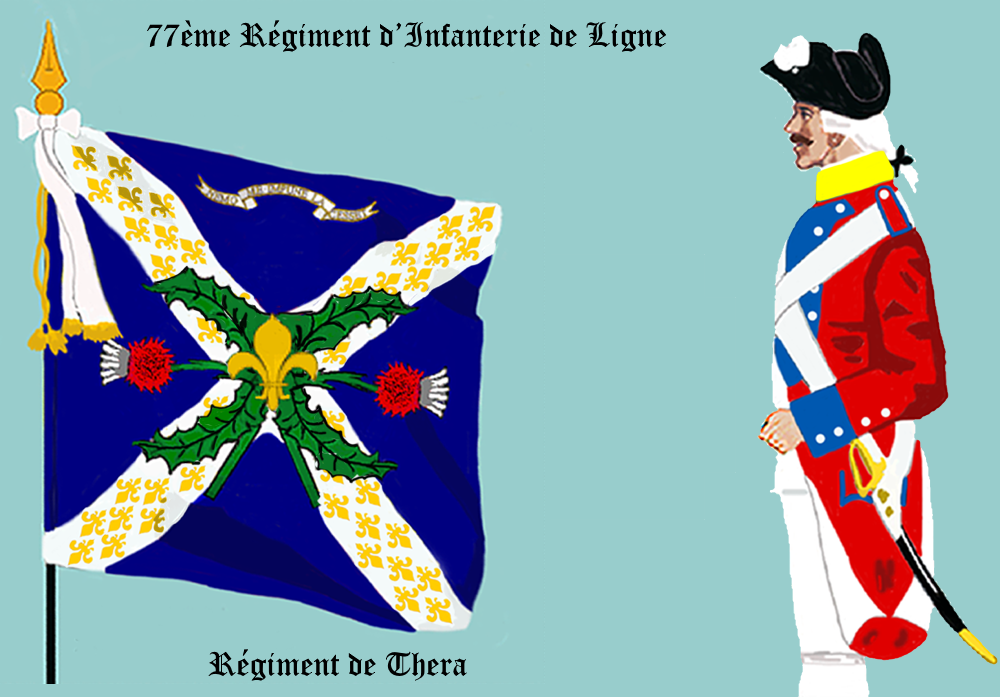
Royal Guard
The Queen's House, or Maison de la Reine are the Elite of the Elite in the Royal Army. They number 10,000 total and are made of elite foreigners and landed gentry from Oiseau.
Guard Infantry:
Numbering 6,000 strong, the Guard Infantry is divided into three contingents.
Oiseaux Guards
The best infantry in Oiseau, they make up 3 of the Regiments in the Guard Infantry
1er Régiment d’Infanterie de la Garde
2ème Régiment d’Infanterie de la Garde
3ème Régiment d’Infanterie de la Garde
Musketeers of the Guard
The Musketeers of the Guard, or Mousquetaires de la Garde have a storied tradition as excellent foreign fighters from the Candy Kingdom. They serve as some of the personal guards of the Queen herself.
Grenadiers of the Guard
From Pomerania, comes the Grenadiers of the Guard or Grenadiers de la Garde. Out of all of the guard infantry, these men are the greatest of them all and have been unbeaten on the Battlefield. Unlike the Musketeers of the Guard, these men regularly fight on the frontlines
Guard Cavalry:
4 Regiments of Guard Cavalry exist, all drawn from the Gentry and Nobles of the Realm. Extremely well trained and trained, these Cavalrymen are the best of the best. They include:
The Life Guards or Garde du Corps
Gendarmes of the Guard or Gendarmes de la Garde
Horse Grenadiers or Grenadiers à cheval
Light Horse of the Guard or * Chevau-légers de la Garde*
The Life Guards are amongst the Queen's personal guards and rarely see combat but the other three are used much more in combat roles.
Officers:
The Royal Army prides itself on being an effective and innovative fighting force. The Royal Staff College or Collège d’état-major de l’Armée royale is based in the city of Orléans and is where all officers are trained for their service. All local officers come from Noble or Gentry backgrounds but there are foreign officers employed from Pomerania mainly, who are renown as great drill officers. The Royal Staff College indeed was an idea of a Pomeranian, Hans-Pomu von Bülow, a favourite of Queen Louise XVI. He told the Queen that one of the major problems that the army faced was a lack of properly trained officers in the art of war and thus he recommended the establishment of a staff college, where all officers could be trained in the science of war at. The Staff College was founded in 1087 and has changed the fortunes of the Royal Army in the long term.
Marine Royale
The Royal Navy or La Marine Royale stands as the first line of defense from foreign invasions by sea. Given the neglect it was shown in the reigns of Louise XIV and Louise XV that resulted in the establishment of the Caliphate, the Royal Navy has seen major investments and reforms with the assistance of the Imperial Navy of Nijisanji to restore her to her former glory.
Organization:
The Royal Navy has two distinct fleets, operating out of 4 Naval Districts as of now. The Two fleets are the Western Fleet or Flotte de l’Ouest and the Eastern Fleet or Flotte de l’Est. Since the Western Fleet is limited in size and scope, it has one Naval District while the Eastern Fleet has three.
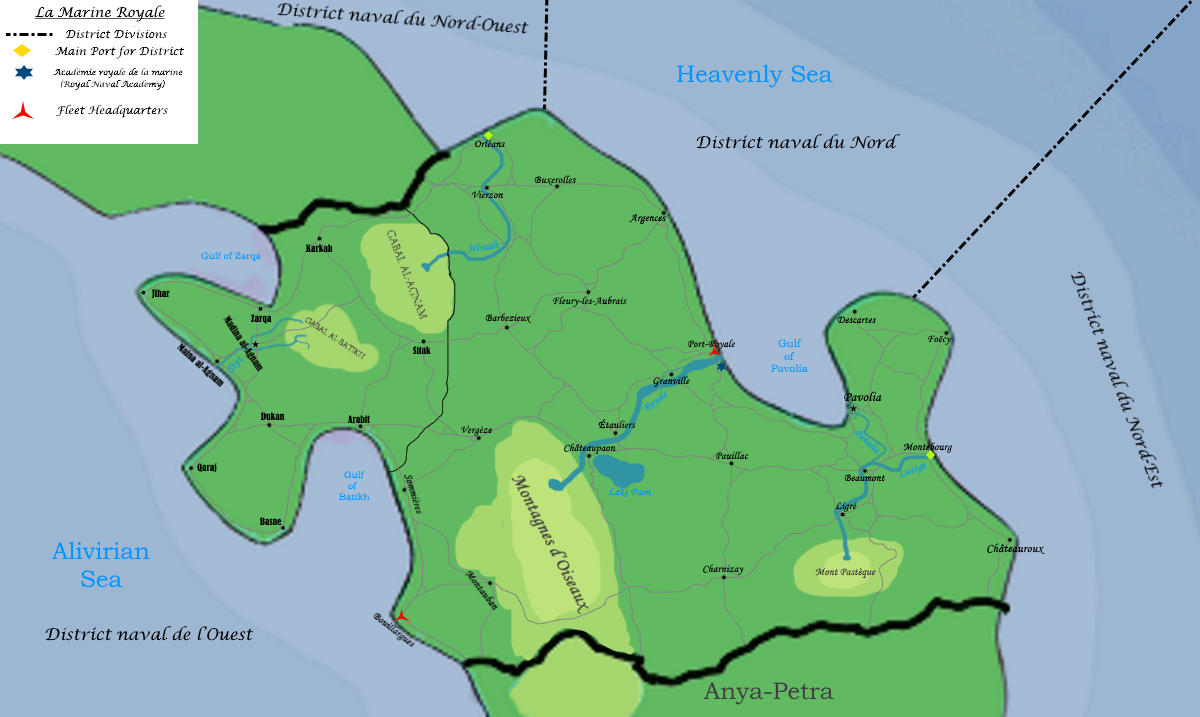
The Admiralty or Amirauté royale d’Oiseau and Royal Naval Academy or Académie royale de la marine is located at Port Royale, the largest and greatest of all of the ports in the Kingdom. From here also is based the Northern Naval District or District naval du Nord, and the Northern Fleet itself.
The Western Fleet, which traditionally operated out of the port of Rochefort (Now Maina al-Agman) now operates from the much smaller port of Bouillargues and as a result has been reduced in size.
The Navy furthermore uses the «Ranking System» to classify its Ships-of-the-Line and Frigates.
1st Rank, 100+ Guns
2nd Rank, 80 to 98 Guns
3rd Rank, 60 to 78 Guns
4th Rank: 44 to 58 Guns
5th Rank: 36 to 42 Guns
Ships that carry less guns that these are classified based on their rigging and use. As part of the partnership with the Empire of Nijisanji, many of these ships have been built as classes and the standardization as part of the Naval Reform Edict of 1098.
Note: NSM translates to Her Majesty's Ship or Navire de Sa Majesté
Ships-of-the-Line:
There are 26 Ships-of-the-Line in the Royal Navy, including 2 First Ranks, 2 Second Ranks, 20 Third Ranks, and 2 Fourth Ranks. The two remaining 4th Ranks, considered out of date for Line of Battle tactics of the day, are the only Ships of the Line in the Western Fleet.
This is current roster of the Royal Navy's Ships-of-the-Line.
First Ranks
NSM Royal Louise, 110 guns. Fleet Flagship, Eastern Fleet
NSM Soleil Royal, 110 guns. Eastern FleetSecond Ranks
NSM Victorieux, 80 guns, Eastern Fleet
NSM Sceptre, 80 guns, Eastern FleetThird Ranks
NSM Tigre, 74 guns, Eastern Fleet
NSM Formidable, 74 guns, Eastern Fleet
NSM Indivisible, 74 guns, Eastern Fleet
NSM Foudroyant, 74 guns, Eastern Fleet
NSM Juste, 74 guns, Eastern Fleet
NSM Aimable, 74 guns, Eastern Fleet
NSM Superbe, 74 guns, Eastern Fleet
NSM Invincible, 74 guns, Eastern Fleet
NSM Terrible, 74 guns, Eastern Fleet
NSM Magnifique, 74 guns, Eastern Fleet
NSM Téméraire, 74 guns, Eastern Fleet
NSM Diadème, 74 guns, Eastern Fleet
NSM Souverain, 74 guns, Eastern Fleet
NSM Protecteur, 74 guns, Eastern Fleet
NSM Conquérant, 74 guns, Eastern Fleet
NSM Monarque, 74 guns, Eastern Fleet
NSM Duc d'Orléans, 64 guns, Eastern Fleet
NSM Phénix, 64 guns, Eastern Fleet
NSM Espérance, 64 guns, Eastern Fleet
NSM Courageux, 64 guns, Eastern FleetFourth Ranks
NSM Solitaire, 56 guns, Fleet Flagship, Western Fleet
NSM Réfléchi, 56 guns, Western Fleet
Frigates:
There are 30 Frigates in the Royal Navy currently, including 6 4th Rank Frigates, 4 4th Rank Razées and 20 5th Ranks. 12 of these ships are the backbone of the Western Fleet in their attempts at stopping Corsairs from the Caliphate from taking slaves in the region. All 4 Razées are located in the Western Fleet as well. A «Razée» is an older Ship-of-the-Line which has been «cut down» in to serve as a Frigate. They have the benefits of the Ship-of-the-Line's hull construction with the speed and agility of Frigates.
Lighter Ships:
22 Corvettes, 10 Brigs, 36 Galleys and numerous other gunboats, harbor patrol and other vessels are part of the Royal Navy. The Corvettes and Brigs are mostly station in the Eastern Fleet, where their use is fair greater. Only 6 Corvettes and 2 Brigs are in the Western Fleet. However, all 24 Galleys are stationed in the Western Fleet, where they still serve a useful purpose, albeit one that is increasingly growing obsolete and there is a plan to build more Corvettes and Brigs for the Western Fleet in the near future to replace these antiquated vessels.
Special Ships:
The Royal Navy also has some special vessels dedicated to interesting purposes. These included Bomb Ketches, and Fire ships. There are currently 8 Bomb Ketches and 16 Fire Ships in the fleet, with the former being in the Eastern Fleet and the latter being in the Western Fleet.
Naval Officers:
Royal Naval Officers come largely from the nobility and are trained in modern tactics by the Royal Naval Academy. This doesn't mean that all officers are nobles, as a few from the middle class have found their way into command and ultimately being ennobled due to their skill.
Royal Special Forces:
Various espionage units have been set up by Queen Louise XVI to combat the threats of terrorism and hostile nations. All we know about these forces is that they are directly commanded by the Queen herself and that they lurk in the shadows everywhere in the Kingdom and other nations beyond; trained to perfection in the art of infiltration and disguise. The names of these units are mostly unknown, with one we do know the name of one of them being The White Tulips ,Les tulipes blanches, who assassinated a Batikh General in 1110 VTE. Nothing more is known about them or others.
Foreign Relations:
Candy Kingdom:
A true and noble friend, who provides us with our Musketeers of the Guard. We love these people for their long tradition of nobility and monarchy, and they are our closest friend.
Mononobe Shogunate:
A Friendly, noble and honourable state which we want close ties with. They exert much power over the world and whilst we condemn their corporations, we do see that they are fighting against the vile republicans and thus we stand by them as friends. Furthermore, they have helped us over the years in gracious way and our cooperation has left us feeling flattered by them.
K.A.G.
The more reasonable of the two companies, we allow them to set up their own facilities on the Island of Île-Majestueux outside of the port of Bouillargues for a reasonable price. In return, they provide us with great stocks of fine metals, precious gems, spices, and luxury goods; as well as efforts to fortify the harbor. They have also a similar arrangement Île-Royale outside of Port Royale as well, and we allow them as a whole to trade with our nation as a whole. They may be greedy, but their greed is to our benefit, and we consider them to be dear friends of our nation.
C.I.O.
The less honourable cousin of the K.A.G.; their fight against the enlightenment is honourable but the same cannot be said about their actions in Syndeoneia. They are ruthless capitalists, and we have little trust for them. But as with the K.A.G., their imports are appreciated and we have allowed them to establish facilities at the port of Montebourg, away from the K.A.G., to conduct their business from. However, they are forbidden from leaving their assigned merchant quarters.
Risuners:
Tribals who may cause us problems.
Empire of Ninisani:
A divided Empire with some interesting members.
Kingdom of Pomerania:
A noble Kingdom, led by a great man. They provide us with Étrangers and have forged close ties with us in recent years. We find them perhaps too warlike, but it is good to have such a nation as a friend. We have also proposed the marriage of the Crown Princess Louise to the Pomeranian Crown Prince in order to form a great friendship and seal an alliance with them and the other Kingdoms that their ruler Pomerlane rules over with his wife.
Archduchy of Eliria:
A realm worthy of our praise, for they too are cultured like us. Their empress is quite the charmer, and we would like closer relations with them.
Kingdom of Selenium:
A warlike Isolationist Kingdom. They have expressed the desire to cooperate and learn from us and we will certainly take this request to heart.
Moriji:
Our friends in the Alvirian Sea. We may not agree on all things, but we have always worked together. A true friend.
Infintium:
A nation whose reputation speaks for itself. An unadultered cesspit of degeneracy, corruption, and treachery. They so gracious said they would be outraged if the cannibals attacked us but couldn't stop them! What vile apoplexy the must have! One day, they shall fall to the sin that consumes them.
Serene Republic:
A bunch of men who seek glory and honour via wealth but fail to realize it does not come from that source. We have nothing in common but feel slightly negatively about them.
Empire of Syndeoneia:
A state in turmoil that shares many values as we do. We hope they overthrow the chains of the C.I.O. and are willing to negotiate with the Shogunate as a neutral party should this happen where both parties can have peace with honour.
Towa:
A nation which shares the same perils as we do with Risuners. We sympathize with them and like their government.
Retro Reich:
A trader nation from Indeia that has robots. They seem to be alright by having a monarchy.
Mans:
They do not exist yet.
Republic of Owl:
This nation is republican and secular, but the enemy of our enemy is our friend. It may take time to build trust but we are open to it.
Republic of VSJ:
This nation, like it's Pact below, represent everything that runs counter to Her Majesties' Beliefs. Their attempts at meddling in the affairs of a legal treaty between multiple nations is a dishonourable and condemnable act of aggression and malice that interferes with the stability of their continent. As such, true friends of us shall not be friends of this nation under any circumstances. They run counter to civilization and are uncouth.
The Western Horse Pact:
We reject this obtuse and revolutionary alliance as the work of all evil in the world. Their beliefs run contrary to everything Her Majesty stands for and thus we will take any member of this group, especially ones that join near us, as mortal enemies. We caution the world to reject these preposterous values this pact upholds.